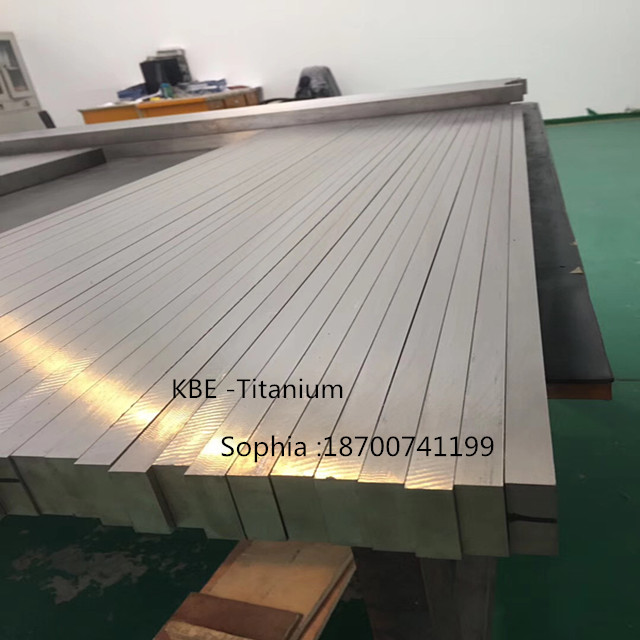The reaction of titanium alloy materials such as titanium rod and titanium tube in air is closely related to temperature |
Titanium rods, titanium tubes and other titanium alloy materials react in the air, usually with oxygen, nitrogen, hydrogen, these three non-metallic elements, their reaction process and temperature are closely related. Titanium reacts with oxygen in the air. Below 100℃, it is very slow, and only the surface is oxidized at 500℃. With the increase of temperature, the surface oxide film began to dissolve in titanium, and oxygen began to diffuse into the inner metal, but at 700℃ oxygen has not entered the inner metal lattice. When the temperature exceeds 700℃, the diffusion of oxygen into the metal is accelerated, and the surface oxide film loses its protective effect at high temperature. The reaction of titanium with oxygen depends on the form and temperature of titanium. Powder titanium in the air at room temperature, due to static electricity, spark, friction and other effects of violent combustion or explosion. However, dense titanium is stable in the air at room temperature. When dense titanium is heated in the air, it begins to react with oxygen. At first, oxygen enters the lattice on the surface of titanium and forms a dense oxide film. The oxide film on the surface of this layer can prevent oxygen from diffusing internally and has a protective effect. The color of the oxide film on its surface is related to the generation temperature. It is silver-white below 200℃, light yellow at 300℃, golden yellow at 400℃, blue at 500℃, purple at 600℃, red gray at 700 ~ 800℃, and gray at 800 ~ 900℃. In pure oxygen, the initial temperature of intense reaction between titanium and oxygen is lower than that in air, and titanium burns in oxygen at about 500 ~ 600℃. Titanium does not react with nitrogen at room temperature, but at high temperature, titanium is one of the few metal elements that can be burned in nitrogen. The reaction between molten titanium and nitrogen is very intense when the combustion temperature of titanium in nitrogen is about higher than 800 degrees. The reaction of titanium and nitrogen, in addition to the formation of titanium nitride (Ti3N, TiN, etc.), also form Ti -- N solid solution. When the temperature is 500-550 ℃, titanium begins to absorb nitrogen obviously and form interstitial solid solution. When the temperature reaches more than 600 degrees, the speed of titanium nitrogen absorption increases. In Ti-N solid solution, the temperature of titanium phase transformation increases because nitrogen enters into the lattice of titanium in the form of titanium nitride. Nitrogen is also a stabilizer of titanium. At 1050 ℃, the maximum solubility (mass fraction) of nitrogen is 7%, and at 2020 ℃, the maximum solubility (mass fraction) of titanium is 2%. However, the speed of titanium absorbing nitrogen is much slower than that of oxygen, so titanium mainly absorbs oxygen in air, while nitrogen absorption is secondary. The reaction of titanium with oxygen depends on the form and temperature of titanium. Powder titanium in the air at room temperature, due to static electricity, spark, friction and other effects of violent combustion or explosion. However, dense titanium is stable in the air at room temperature. When dense titanium is heated in the air, it begins to react with oxygen. At first, oxygen enters the lattice on the surface of titanium and forms a dense oxide film. The oxide film on the surface of this layer can prevent oxygen from diffusing internally and has a protective effect. The color of the oxide film on its surface is related to the generation temperature. It is silver-white below 200℃, light yellow at 300℃, golden yellow at 400℃, blue at 500℃, purple at 600℃, red gray at 700 ~ 800℃, and gray at 800 ~ 900℃. In pure oxygen, the initial temperature of intense reaction between titanium and oxygen is lower than that in air, and titanium burns in oxygen at about 500 ~ 600℃. Titanium does not react with nitrogen at room temperature, but at high temperature, titanium is one of the few metal elements that can be burned in nitrogen. The reaction between molten titanium and nitrogen is very intense when the combustion temperature of titanium in nitrogen is about higher than 800 degrees. The reaction of titanium and nitrogen, in addition to the formation of titanium nitride (Ti3N, TiN, etc.), also form Ti -- N solid solution. When the temperature is 500-550 ℃, titanium begins to absorb nitrogen obviously and form interstitial solid solution. When the temperature reaches more than 600 degrees, the speed of titanium nitrogen absorption increases. In Ti-N solid solution, the temperature of titanium phase transformation increases because nitrogen enters into the lattice of titanium in the form of titanium nitride. Nitrogen is also a stabilizer of titanium. At 1050 ℃, the maximum solubility (mass fraction) of nitrogen is 7%, and at 2020 ℃, the maximum solubility (mass fraction) of titanium is 2%. However, the speed of titanium absorbing nitrogen is much slower than that of oxygen, so titanium mainly absorbs oxygen in air, while nitrogen absorption is secondary. |

